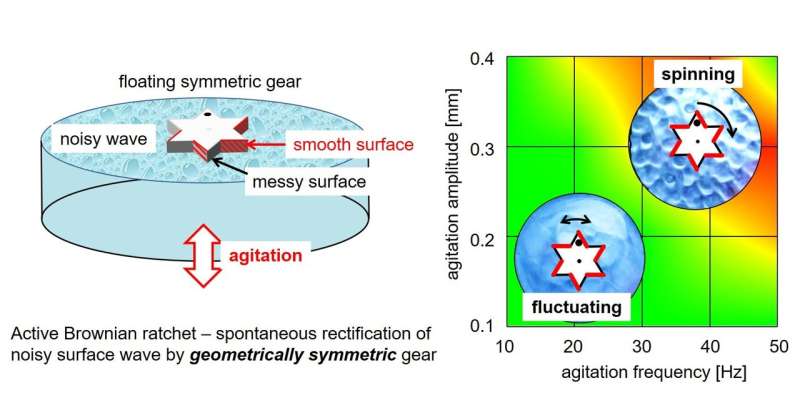
August 20, 2024 by Doshisha University
Collected at: https://phys.org/news/2024-08-ratchet-mechanism-geometrically-symmetric-gear.html
The ratchet mechanism is a fascinating energy-conversion system that converts disorderly or random motion into orderly, directed movement through a process known as spontaneous rectification. It is a critical component of mechanical systems, typically consisting of a gear and a pawl, which restricts the movement of the gear in one direction.
In biological systems, the concept of a Brownian ratchet has been proposed to help understand the mechanism of molecular motors, where chemical reactions rectify the random thermal motion of molecules.
According to the second law of thermodynamics, uniform thermal fluctuations cannot spontaneously generate regular motion. Practical Brownian ratchets therefore require nonequilibrium fluctuations to function.
Physiological chemical reactions in biological systems modulate thermal motion and are known to generate nonthermal fluctuations, which may be crucial for the ratchet mechanism. Moreover, identifying the types of nonequilibrium noisy motions that can be rectified by a ratchet mechanism is an intriguing and fundamental question in science, facilitating the development of novel energy-harvesting technologies.
The Feynman–Smoluchowski ratchet is a classic example of an active Brownian ratchet, which has led to numerous ratchet motor studies.
In most of these studies, the ratchet mechanism involves using a geometrically asymmetric ratchet to rectify nonthermal fluctuations derived from mechanical vibrations.
In a breakthrough, a team of researchers from the Department of Chemical Engineering and Materials Science, Doshisha University, led by a Ph.D. student Miku Hatatani, along with Associate Professor Yamamoto Daigo and Professor Akihisa Shioi, developed a novel ratchet mechanism based on the asymmetry of surface wettability using a geometrically symmetric gear.
“We realized a new model of an active Brownian ratchet motor that utilizes the surface-energy profile for the ratchet mechanism. This is quite different from conventional geometrically asymmetric ratchets and is closer to the biological one,” explains Hatatani.
Their study was published in the journal Scientific Reports on July 18, 2024.
The innovative ratchet mechanism developed by the team involves a geometrically symmetric star-shaped gear made of acrylonitrile butadiene styrene (ABS) resin, with six triangular teeth. Parafilm is attached alternatively to the right side of each tooth, as viewed from the front face of the gear, resulting in a difference in surface wettability between the two faces of the teeth.
The gear was tested by placing it in a water-filled petri dish, with its front facing a camera mounted on top of the dish. The gear was fixed with a push pin through a drilled hole in its center. The petri dish was placed on a vibrating disk that oscillated vertically at a pre-determined frequency, producing random fluctuations in water.
The gear with the parafilm demonstrated a one-way spin in the waterbed with vertical oscillations in a restricted range of frequency and amplitude.
In contrast, the gear without the parafilm did not exhibit a one-way spin for any frequency or amplitude. The one-way spin for the parafilm gear was determined by the chirality of the gear, meaning that the spinning direction was opposite when viewed from different faces.
More information: Miku Hatatani et al, Surface-energy ratchet motor with geometrical symmetry driven by biased random walk, Scientific Reports (2024). DOI: 10.1038/s41598-024-67383-1
Journal information: Scientific Reports

Leave a Reply